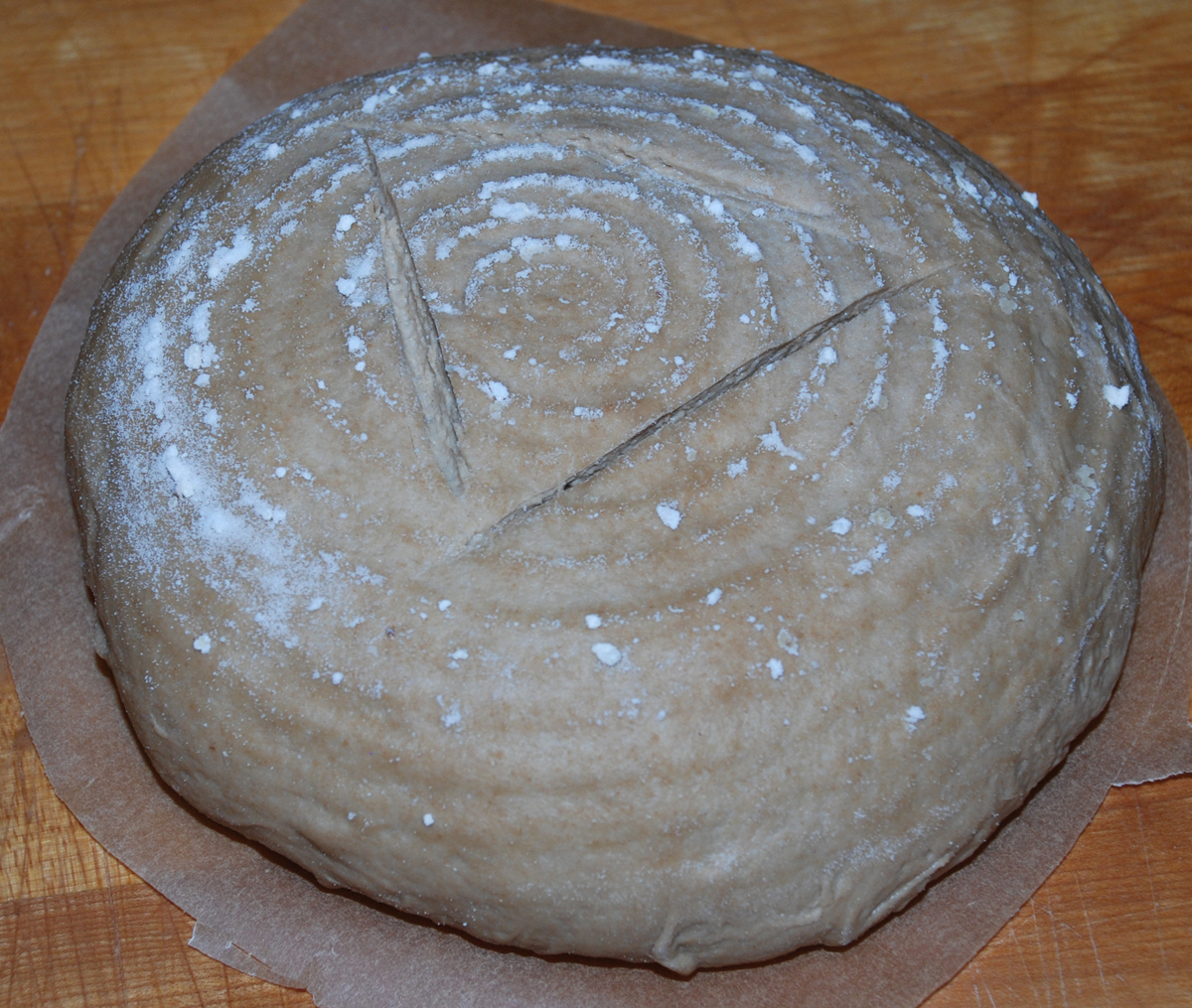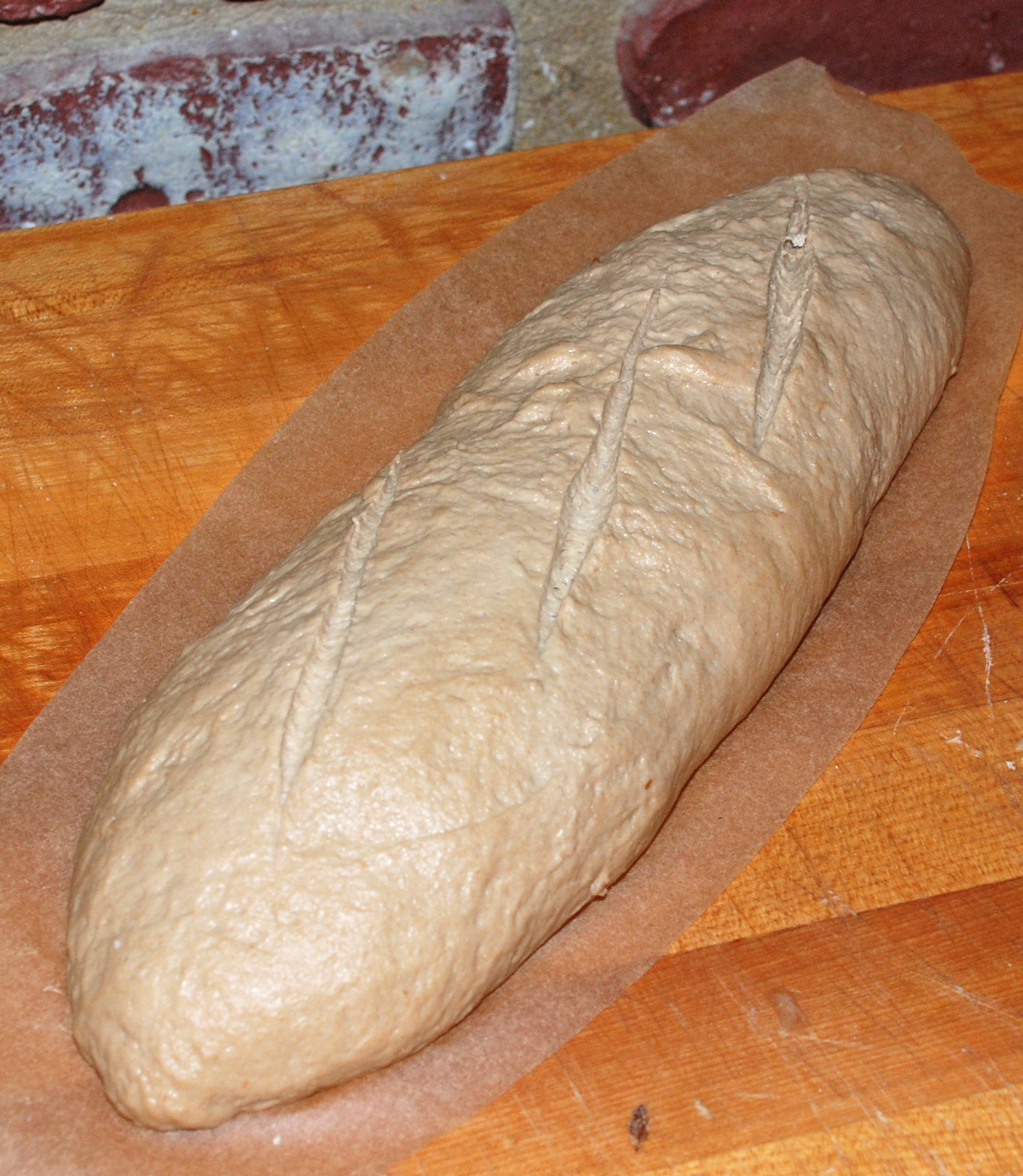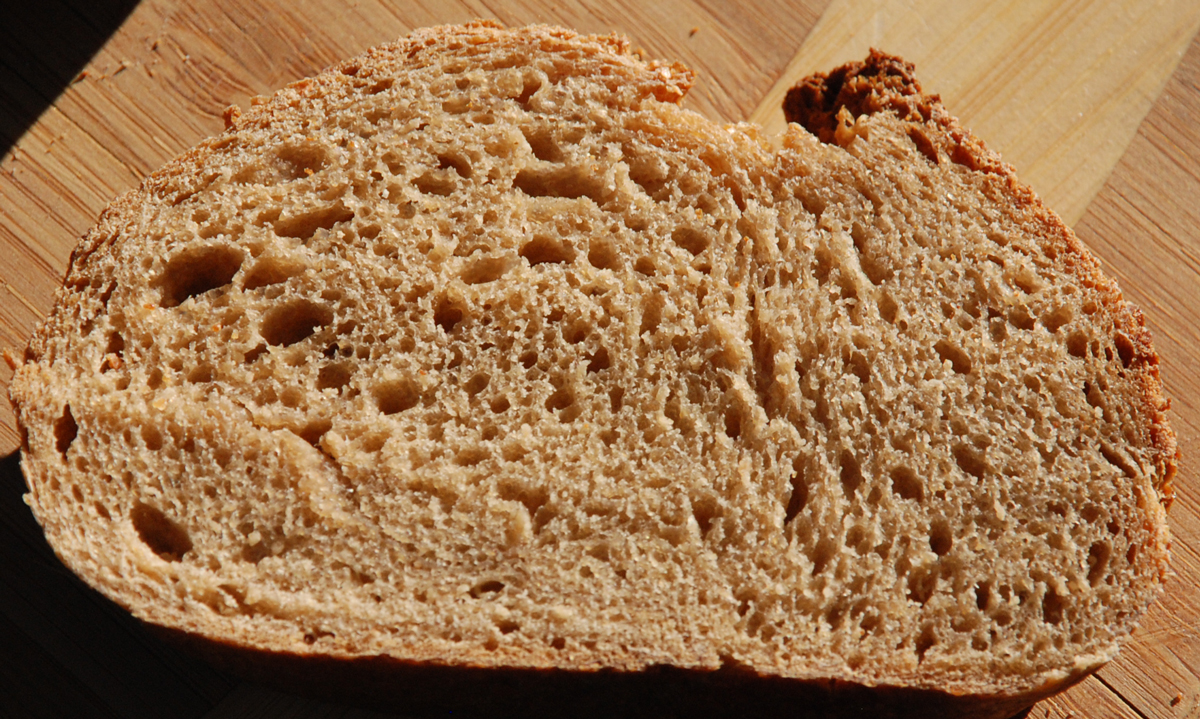 My wife bought a bottle of Chocolate Stout about a month ago with the intentions of making some kind of chocolate cake. This would have been a very good use for this stout, but since she never had a chance to put it to good use I decided it was time to give it a try in a bread. I recently purchased another new flour which I have since found out is a very old flour called Amaranth. I decided to combine this with some sprouted wheat flour, KAF European style flour along with a Yeast Water starter and my stock AP starter. I used some Italian style 00 flour in the Yeast Water build which I built up in 2 stages. If I made this again I would probably increase the hydration since it is only around 68% and I think the crumb would have been more open with a higher hydration.
My wife bought a bottle of Chocolate Stout about a month ago with the intentions of making some kind of chocolate cake. This would have been a very good use for this stout, but since she never had a chance to put it to good use I decided it was time to give it a try in a bread. I recently purchased another new flour which I have since found out is a very old flour called Amaranth. I decided to combine this with some sprouted wheat flour, KAF European style flour along with a Yeast Water starter and my stock AP starter. I used some Italian style 00 flour in the Yeast Water build which I built up in 2 stages. If I made this again I would probably increase the hydration since it is only around 68% and I think the crumb would have been more open with a higher hydration.
Yeast Water Starter Build 1
100 grams Italian Style 00 Flour (KAF)
100 grams Yeast Water Starter
Mix the flour and Yeast Water in a bowl until thoroughly combined. Cover the bowl and let it sit at room temperature for around 4 hours. The starter should almost double when ready to proceed to build 2.
Build 2
Add ingredients below to starter from above and mix until incorporated. Cover with plastic wrap and let sit at room temperature for 4 hours.
100 grams Italian Style 00 Flour
35 grams Yeast Water
Main Dough Ingredients
107 grams Refreshed AP Starter (65% hydration)
318 grams Italian Yeast Water Starter (all of starter from above)
200 grams Sprouted Whole Wheat Flour or Whole Wheat Flour
150 grams Amaranth Flour
405 grams European Style Flour (KAF) or Bread Flour
161 grams Mashed Potatoes (I like to mash them with the skins on and used red potatoes)
503 grams Chocolate Stout at room temperature
16 grams Raspberry Champagne Vinegar
16 grams Salt (Sea Salt or Table Salt)
Procedure
Mix the starters with the stout but save 50 grams for later (no... don't drink it!) and stir to break it up. Next mix in the flours into the starter mixture and mix for 2 minutes with your mixer or by hand. Let the dough autolyse for 20-30 minutes to an hour in your bowl covered with a cloth or plastic wrap. Next add in the salt, balance of Stout and vinegar and mix on speed #2 for 4 minutes or by hand. The dough should have come together in a ball and be tacky but not too sticky.
Next take the dough out of the bowl and place it on your work surface. Do a stretch and fold and rest the dough uncovered for 10 minutes. After the rest do another stretch and fold and cover the dough and let it rest for 10 minutes. Do one more stretch and fold and put the dough into a lightly oiled bowl and let it sit at room temperature covered for 2 hours. After 2 hours you can put the dough into the refrigerator for 24 hours or up to 2 days before baking. Feel free to do some additional S & F's if you feel it is necessary.
The next day (or when ready to bake) let the dough sit out at room temperature for 1.5 - 2 hours. Next, form the dough into your desired shape and put them in floured bannetons, bowls or on a baking sheet and let them rise covered for 2 hours or until they pass the poke test. Score the loaves as desired and prepare your oven for baking with steam.

Set your oven for 500 degrees F. at least 30 minutes before ready to bake. When ready to bake place the loaves into your on your oven stone with steam and lower the temperature immediately to 450 degrees. It should take around 20 - 30 minutes to bake until both loaves are golden brown and reached an internal temperature of 200 - 210 degrees F.
Let the loaves cool down for at least an hour or so before eating as desired.
- Isand66's Blog
- Log in or register to post comments




Those breads look very tempting. The crumb color is very nice - I suppose from both the stout and the yeast water. Looks like great eating. -Varda
Thanks Varda,
Appreciate the comments.
This is a great bread with some sharp cheese for sure!
Regards,
Ian
The bread looks delicious!
I'm curious, though... Why do you add vinegar to the dough? Is it for taste, or does it affect the fermentation somehow?
I'm just getting ready to mix the ingredients for my second attempt with YW, this time with some sourdough as well. So, in other words: thanks for the inspiration!
I had seen someone else add vinegar to a bread so I tried it once before. You don't really taste it but it does combine with the other ingredients and adds to the flavor. I don't think it really affects the fermentation that I'm aware of.
Thanks for the comments.
Regards,
Ian
Great breads, Ian! I think you've underproofed them, but they look great nevertheless. What is the flavor like with all the stout?
The crumb looks smooth and tatsy!and the crust color is absolutely beautiful! you've nailed the crust color i strive to achieve. With all the dissolved sugars from the stout, one must take care with oven temperature.
Khalid
Thanks Mebake....I think I may have underproofed them as you suggested. With my house a little hotter than usual I think I was afraid I would overproof them.
You do taste the stout for sure. Since I used mostly a yeast water starter the bread was not as sour as it usually would be if I had used only my normal sourdout AP starter. The amaranth flour has a unique flavor as well, which I'm not sure how to describe.
Thanks again for your kind words.
Regards,
Ian
says she likes this bread because it has chocolate in it. I tried to explain that there wasn't any real chunks of dark chocolate in it but she's not listening mumbling something about how she saw double chocolate and that 's it for her. I think she's been hitting the stout a little early today but wants to know if you taste the double shot of chocolate?
Anyway, I really like the crust on this bread and think you could have even made it darker, probably a lot darker, after looking at the crust on the crumb shot, and not hurt it any at all. What was the temp when you pulled out? Did it rest on the stone for 10 minutes with the door ajar and oven off? That stout bread really needs a WFO to get it dark enough on the crust - but not too dark while keeping the crust moist.
The last time we baked with stout, that Lucy didn't snarf up ahead of time, was for St Paddy's Day. It was that green and white soccor ball baked in a DO. The crust nearly came out black with a 205 F interior but it didn't taste burnt at all. I didn't know if it was the stout or the DO that caused it but it sure was good. I'm guessing it wat a little of both.
You have a lot of whole grains in there and that will keep the large holes in check. I like the crumb and it sure has the soft, moist YW calling card all over it. I can't tell if it is underpoofed though and would be last non expert on the subject chosen to figure it out but Khalid is a fine baker and he would know. How he knows I wish I knew - because I know I am guilty too from the look of your crumb :-)
Did you retard this bake? From the looks of the crumb, it looks like it doubled, the bottom isn't compressed much and it passed the poke test. Some breads apparently don't do the poke test well but I don't know which ones they are either. - maybe high rye content? Maybe someone will know. I don't bake much below 72% hydration and I sometimes don't get as nice an open crumb like this one - especially when so much whole grains are involved.
Clayton says that you can put a pinch of cumin or vinegar in bread to to give it a better taste. What he means by that I don't know. I put both in my SD multi-grain challah loaf for this reason - that Clayton said so. I also think the vinegar makes for a slightly more acid atmosphere that the yeast really likes when it comes to sour not that vinegar itself isn't sour enough already.
I'm going to try making this bread in a DO and see what happens to the crust - once I start baking bread again.
I'm not a big amaranth fan but I sure like potato in bread. This bread has to be tasty and one of your finer concoctions.
Sorry this is so long and windy. Very nice baking Ian as usual. Got SD Rye Knots Rolls with Scald and Seeds proofing for dinner.
Thanks DA for the lengthy comments. I don't mind at all. I took the loaf out when it hit around 205 internal temperature. I didn't leave it in the oven with the door cracked this time since it was getting late and I needed some sleep.
I've baked with much higher a % of grains in the past and ended up with a more open crumb so I think Kahlid may be right and it could have used another 30 minutes proofing time.
Let me know how it comes out.
I can't wait to see how your rolls come out.
I just mixed up a "Holy Guacamole" bread. We will see how this one comes out tomorrow.
Regards,
ian
underproofed them by a wide margin. I had to get them in the mini oven oven for dinner and ran out of time. Should have chucked them in the fridge for an overnight sleep instead:-) They look good on the outside as they cool.
Now I have to look up 'holy guacamole' bread :-)
FYI the crust was actually very dark but the bright lighting makes it look much lighter.
Ian